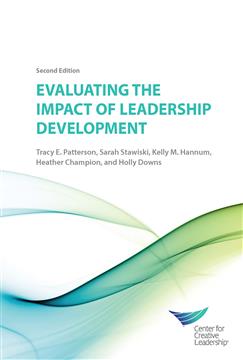Every organization that invests in leadership development must conduct leadership evaluation and determine how the benefits stack up to the time and money invested.
Are you responsible for evaluating outcomes and communicating the findings to decision-makers and interested stakeholders alike? A practical framework for gathering and making sense of information will help you.
We have compiled our best, most hands-on learning about leadership evaluation in the second edition of Evaluating the Impact of Leadership Development.
Created for anyone who has leadership development or evaluation responsibilities, this short leadership evaluation how-to guide includes everything you need to organize, implement, and report on the impact of leadership development programs.
Why Evaluate the Impact of Leadership Development?
4 Lost Opportunities When You Don’t Conduct Leadership Evaluation
After the expense and effort of launching a leadership development program, evaluation may seem like an extra or unnecessary step. Yet without it, you’re missing many benefits and major learning opportunities of evaluation. Here are 4 opportunities you’ll miss unless you evaluate your process:
- Understanding if the initiative achieved the intended goals.
- Communicating results to the people responsible for outcomes.
- Taking actions based on lessons learned through the leadership development process.
- Making the case for continuing or ending the program.
Leadership evaluation is the framework for gathering and making sense of information to help you assess the success of leadership development efforts and make sound decisions about future investments. Each organization will have various reasons to evaluate their initiative — some will be more focused on how to improve a program while others are following conditions set by a funder. Many organizations choose to undergo an evaluation to ensure their leadership programs suit the cultural needs of the organization.
The 6 Stages of the Leadership Evaluation Cycle
 The latest edition of Evaluating the Impact of Leadership Development combines a foundational approach to evaluate a program with examples of evaluation design processes and tools specific to leadership development, and is organized according to these 6 stages of the leadership evaluation cycle:
The latest edition of Evaluating the Impact of Leadership Development combines a foundational approach to evaluate a program with examples of evaluation design processes and tools specific to leadership development, and is organized according to these 6 stages of the leadership evaluation cycle:
- Understanding the evaluation function and process.
- How to gather information, plan, and conceptualize the evaluation.
- Ways to identify and engage the people who care about your program.
- Easy steps for collecting and analyzing data.
- How to interpret and communicate evaluation findings.
- Best methods to implement changes and share lessons learned.
The Who, What, When of Top-Notch Leadership Evaluation Design
5 Questions to Ask
A hallmark of leadership evaluation is to provide observers, participants, and decision-makers with a sense of how well something is working, or not. A good evaluation design is based on a solid understanding of the expected outcomes of the program and an understanding of who cares about the program, and what their expectations are.
To achieve a good leadership evaluation design, you should ask 5 key questions:
1. Who are the people who care most about the evaluation findings?
The leadership evaluation will be most useful if it’s designed based on the expectations, concerns, and perceptions of key stakeholders. Stakeholders could be those who are involved directly — participants or the program staff — as well as organizational leaders and others who could invest in the initiative or are affected by it.
2. What changes do we expect from our program?
Evaluation design is based on knowing the connection between each program element and what it’s trying to achieve. What knowledge and skills is the program designed to develop? What actions or behaviors reflect those desired lessons learned? How will we know learning has occurred? What’s the definition of success? What degree of improvement is expected?
When these questions are answered by stakeholders early on, it can not only inform what you evaluate but also strengthen the program design. It can reveal details that had been overlooked as well as unnecessary elements or gaps in the program design.
3. What’s most critical to measure?
Narrowing the scope of what you evaluate to what’s most critical is the next step. If you breeze through this part of the process, it’s easy to end up collecting more information than you need or miss collecting data that ends up being of great interest to your stakeholders. Plus, you can avoid conflict down the road if you can simplify and summarize the evaluation so that stakeholders get another chance to buy in to what you’re doing.
As you think through the factors you want to measure, consider our simple framework for evaluating training outcomes. Our researchers developed this framework after decades of implementing and evaluating the success of leadership development programs.
First, understand the levels of impact a development program can have. These 4 levels range from the individual, to the group, to the entire organization, to all of society. Levels of impact are connected outcomes that ripple outward over time; by understanding these levels, you can clarify your expectations.
It’s important to note that not all leadership solutions are expected to exert their impact on all 4 levels; the expected impact on a given level will depend largely on the specific goals of each solution.
Next, consider 3 contributing factors, which include:
- Leadership characteristics: Are participants prepared, and are they fully engaged?
- Leadership solution: This is the content itself, the development’s design characteristics and the way in which it’s delivered.
- Context: Does your organization’s culture and leadership support development?
Our research reveals that, as you consider what’s most critical to measure, it’s helpful to focus on the factors that can actually help to maximize the impact of your leadership development initiatives. That way, you ensure the design of the solution is relevant to the challenges faced by your leaders, is delivered in a way that engages leaders, and accounts for contextual factors.
4. How will we gather useful data?
Each data-collection method has a purpose. For example, behavioral change can be captured by a 360-degree assessment designed to measure change, while focus groups or interviews are a useful way to gain an in-depth understanding of the obstacles people face in implementing desired behavioral changes.
End-of-program leadership evaluation surveys measure immediate responses to the program, but they don’t reveal the results of individual development in the way that post-program surveys and interviews can. Social media, phone apps, pulse surveys, and self-monitoring technologies enable you to capture real-time and continuous feedback for participants, along with rich data on behaviors and their impact on business results.
5. What did we learn, and what do we do about it?
The whole reason you evaluate an initiative is to draw meaningful conclusions from data and use them to make informed choices. So it’s important to build in time and commitment to discussing evaluation results, as well as planning how to use them.
If you’ve identified the definition of success for those involved in the program and its future, you’ll be able to present defensible interpretations of the data and make valuable recommendations for how to improve and continue the program.
Ready to Take the Next Step?
Whether you’re a seasoned leadership evaluation professional or a first-timer, partner with our Leadership Analytics and Evaluation team and let our experts show you how to evaluate leadership development.











